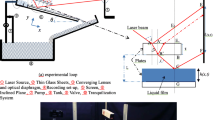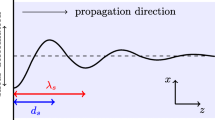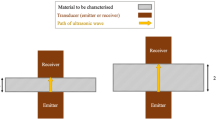Abstract
A novel millimeter wave (MMW) rheometry is developed to determine the viscosity of fluids based on an unsteady film flow on an inclined plane. The method measures fringes due to MMW interference between the front and back surfaces of a fluid flowing across the field of view of a ceramic wave guide coupled to a MMW receiver operating at 137 GHz. With knowledge of the dielectric constant, the interference fringe spacing is used to calculate the thickness of the fluid layer. This thickness is then transformed into the viscosity by means of a simple hydrodynamic theory. Our results show that the MMW rheometry can practically distinguish between the 30, 100, and 200 Pa·s silicone oils. The geometry of the method allows for potential industrial applications such as measuring viscosity of the flowing slag down the walls of coal gasifiers. The MMW rheometry with simple modifications can be easily extended to measure important non-Newtonian fluid characteristics such as yield stress.



Similar content being viewed by others
References
Bredt PR, McIlwain M, Felmy AR, Moyer BA, Gauglitz PA, Poloski AP, Hobbs D, Subramanian K, Krahn S, Vienna JD, Machara N, Wilmarth B (2008) Scientific opportunities to reduce risk in nuclear process science. Pacific Northwest National Laboratory Report PNNL-17699, Richland, WA
Burks DG (2007) “Radomes,” antenna engineering handbook, Chap 53. McGraw Hill, New York
Fort JA, Pfund DM, Sheen DM, Pappas RA, Morgen GP (2007) Development of millimeter-wave velocimetry and acoustic time-of-flight tomography for measurements in densely loaded gas–solid riser flow. PNNL Report No. 16626, Richland, WA
Goodwin R, Homsy GH (1991) Viscous flow down a slope in the vicinity of a contact line. Phys Fluids, A 3:515–528
Horowitz F, Michels AF (2008) Analysis of dip coating processing parameters by double optical monitoring. Appl Opt 47:C185–C188
Horowitz F, Yeatman E, Dawnay E, Fardad A (1993) Real-time optical monitoring of spin coating. J Phys III France 3:2059–2063
Huppert HE (1982) Flow and instability of a viscous current down a slope. Nature 300:427–429
Larsen LE (1992) Millimeter wave flow cytometer. U. S. Patent 5,144,224
Liu KF, Mei CC (1989) Slow spreading of Bingham fluid on an inclined plane. J Fluid Mech 207:505–529
Michels AF, Menegotto T, Horowitz F (2005) Optically monitored dip coating as a contactless viscometry method for liquid films. Appl Opt 44:912–915
Nelson D (2007) Method and apparatus for blood flow measurement using millimeter wave band. U. S. Patent 7,267,651 B2
Schwartz LW (1989) Viscous flows down an inclined plane: Instability and finger formation. Phys Fluids, A 1:443–445
Silvi N, Dussan VEB (1985) On the wetting of an inclined solid surface by a liquid. Phys Fluids 28:5–7
Tanner LH (1976) Measurement of viscosity by optical techniques applied to a falling liquid-film. J Phys E 9:967–973
Troian SM, Herbolzheimer E, Safran SA, Joanny JF (1989) Fingering instabilities of driven spreading films. Europhys Lett 10:25–30
Woskov PP, Machuzak JS, Thomas P, Sundaram SK, Daniel WE Jr (2002) Millimeter-wave monitoring of nuclear waste glass melts—an overview in environmental issues and waste management technologies in the ceramic and nuclear industries VII, ceramic transactions. In: Sundaram SK, Smith GL, Spearing DR (eds) The american ceramic society, vol 132, pp 189–202
Woskov PP, Sundaram SK, Daniel Jr WE, Miller DH (2004) Molten salt dynamics in glass melts using millimeter-wave emissivity measurements. J Non-Cryst Solids 341:21–25
Acknowledgements
The authors acknowledge useful discussions with Dr. Paul P. Woskov, Plasma Science and Fusion Center, Massachusetts Institute of Technology. The authors also acknowledge support from Energy Conversion Initiative (ECI) at Pacific Northwest National Laboratory (PNNL) for partial support. PNNL is a multi-program national laboratory operated by Battelle Memorial Institute for the United States Department of Energy under DE-AC06-76RLO 1830.
Author information
Authors and Affiliations
Corresponding author
Rights and permissions
About this article
Cite this article
Chun, J., McCloy, J.S., Crum, J.V. et al. Millimeter wave rheometry: theory and experiment. Rheol Acta 50, 125–130 (2011). https://doi.org/10.1007/s00397-010-0522-1
Received:
Revised:
Accepted:
Published:
Issue Date:
DOI: https://doi.org/10.1007/s00397-010-0522-1




